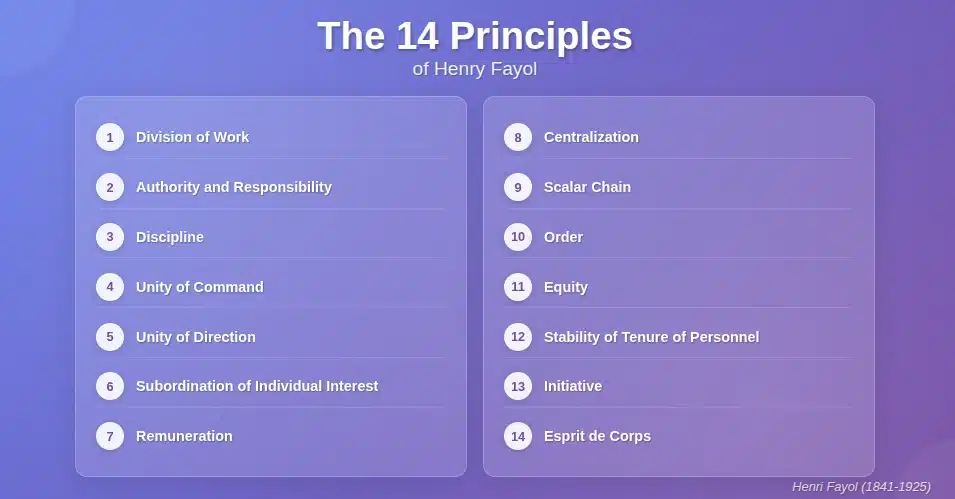You need to understand Henri Fayol's principles. They show up in business courses and interviews. We'll break down what you actually need to know.
Who Was Henri Fayol & Why Should You Care?
Henri Fayol was a French mining engineer in the late 1800s and early 1900s. He wasn't an academic in an ivory tower. He was an executive who took a failing mining company and made it successful. He saw chaos and inefficiency and figured there had to be a logical system to manage people and work.
Historical Context: This was the peak of the Second Industrial Revolution. Factories were scaling up. Management was often random and chaotic. There was no formal training for managers. Fayol’s goal was to create a "theory of administration" that could be taught and applied to any organization, not just a factory. He wrote it all down in his 1916 book, "General and Industrial Management."
You should care because his work is the foundation for much of modern management. Understanding his logic helps you see the structure (or lack thereof) in your own workplace.
Free Leadership and Management Course
Learn the essential skills to inspire your team, plan effectively, and achieve your objectives. Enroll now and become a better leader with our free Leadership & Management Course.
The 14 Principles: A Practical Breakdown
These aren't strict laws. They are guidelines.
- Division of Work
- Authority and Responsibility
- Discipline
- Unity of Command
- Unity of Direction
- Subordination of Individual Interest to General Interest
- Remuneration
- Centralization
- Scalar Chain (Chain of Command)
- Order
- Equity
- Stability of Tenure of Personnel
- Initiative
- Esprit de Corps
1. Division of Work
The core idea is specialization. Break down a complex job into smaller tasks. People get good and fast at their specific task.
- Manufacturing Example: An assembly line. One person installs the engine, another fits the doors. Each becomes an expert at their station, increasing speed and quality.
- Tech Example: A software team isn't just "coders." You have a backend developer for the server, a frontend developer for the user interface, and a QA engineer for testing. Specialization leads to a better product.
Also Read: Workforce Management – Process and Benefits
2. Authority and Responsibility
Authority is the right to give orders. Responsibility is the obligation to see it through. Fayol said they must be connected. Giving someone responsibility without authority is a recipe for failure.
- Healthcare Example: A head surgeon has the authority to direct the surgical team in the operating room. They also hold the ultimate responsibility for the patient's outcome.
- Marketing Example: A project manager is given the authority to assign tasks and deadlines for a new ad campaign. They are then responsible for launching that campaign on time and on budget.
3. Discipline
This isn't about punishment. It's about clear expectations and mutual respect between employees and management. It means obeying the rules that are in place. This requires good superiors at all levels.
- Finance Example: An investment firm has strict rules about insider trading and client confidentiality. Discipline means everyone, from the intern to the CEO, follows these rules without exception. Consequences are clear and applied fairly.
4. Unity of Command
An employee should receive orders from only one supervisor. Period. Getting orders from multiple bosses creates confusion, conflict, and undermines authority.
- Retail Example: A sales associate reports to the floor manager, not the floor manager and the stockroom manager. This prevents situations where they are told to simultaneously restock shelves and help a customer.
Suggested Read: Key Differences Between Leadership and Management
5. Unity of Direction
All teams or groups working on a set of activities with the same objective should be working under one manager and one plan. It ensures coordinated effort.
- Example: A car company wants to launch a new electric vehicle. The design team, engineering team, and marketing team all have different tasks, but they operate under a single plan and a single leader responsible for the overall project. They are all pointed in the same direction.
6. Subordination of Individual Interest to General Interest
The goals of the organization come before the goals of any one individual or group.
- Example: A talented programmer might want to use a brand-new, experimental programming language for a project because it's interesting. However, the company's interest is in a stable, maintainable product. The programmer must prioritize the company's goal over their personal interest in experimenting.
7. Remuneration
Compensation should be fair to both the employee and the employer. It should be enough to motivate people to do good work. This includes financial and non-financial rewards.
- Example: A sales company uses a combination of a base salary (fair to the employee for their time) and a commission structure (fair to the company as it rewards performance). This balances security with motivation.
8. Centralization
This refers to how much decision-making power is concentrated at the top. Fayol didn't say one is better than the other; he said you need to find the right balance for your specific organization.
- High Centralization Example: The military. Decisions flow from the top down. This ensures consistency and control.
- Decentralization Example: A large tech company like Google allows individual engineering teams to make their own decisions about project workflows and tools. This fosters speed and innovation.
Suggested Read: Strategic Management: Meaning & Its Importance
9. Scalar Chain
The line of authority from the top of the organization to the lowest ranks. It's the classic org chart. Communication should typically follow this chain. Fayol also mentioned a "gangplank," allowing communication between employees at the same level in different departments to speed things up.
- Example: If a junior marketing associate needs information from the sales department, they don't go directly to the VP of Sales. They go to their manager, who goes to the sales manager. The "gangplank" would be allowing the associate to talk directly to a sales rep for quick, informal queries.
10. Order
A place for everything and everything in its place. This applies to materials (material order) and people (social order). The right materials in the right place, and the right person in the right job.
- Material Order Example: A warehouse that uses a clear labeling system so workers can find any item in minutes. This minimizes wasted time.
- Social Order Example: Ensuring the person with a deep understanding of data analytics is in the data scientist role, not in a customer service role.
Suggested Read: What is Operations Management? Functions and Importance
11. Equity
Managers should be fair and kind to their subordinates. It doesn't mean treating everyone identically, but it means applying rules and making decisions justly.
- Example: Two employees make the same mistake. Equity means they face the same disciplinary process, regardless of who the manager likes more personally.
12. Stability of Tenure of Personnel
High employee turnover is bad for business. It's inefficient and costly. Management should create an environment that encourages employees to stay.
- Example: A company invests in training and provides clear paths for career advancement. This gives employees a reason to stay long-term, preserving institutional knowledge and reducing hiring costs. Research from the Society for Human Resource Management (SHRM) often finds the cost of replacing an employee can be six to nine months of their salary.
13. Initiative
Organizations should encourage employees to think for themselves and execute their own plans. This creates engagement and innovation.
- Example: A manager outlines a goal ("increase customer engagement on social media") but allows the social media team to devise the strategy and specific campaigns. This empowers the team and leads to more creative solutions.
14. Esprit de Corps
"Union is strength." Management should promote team spirit, unity, and harmony within the organization. A cohesive team is a productive team.
- Example: A manager avoids a "divide and conquer" strategy. They celebrate team wins instead of just individual achievements and encourage open communication to resolve conflicts.
Why These Century-Old Ideas Still Matter
It's easy to dismiss this as "old-school." But the core logic holds up.
- Provides a Foundation: These principles are the DNA of most well-run organizations. Unity of Command and Direction prevent the chaos common in disorganized startups.
- Adaptable: While developed for an industrial setting, they can be adapted. A remote company still needs a clear Scalar Chain (even if it's on Slack) and must foster Esprit de Corps (through virtual events and clear communication).
- Focus on Structure: In a world obsessed with "culture," Fayol reminds us that a clear, logical structure is non-negotiable. As a Harvard Business Review article might put it, "culture doesn't fix a broken organizational structure." The principles provide a blueprint for that structure.
The Big Criticisms You Should Know
Fayol isn't perfect. Be aware of the counterarguments.
- Overly Rigid: Critics say the principles are too formal and don't work for modern, dynamic companies that need to adapt quickly. The Scalar Chain, for example, can slow down decisions.
- Ignores the Human Element: The principles focus on the organization's structure, not the psychology of the worker. They don't dig into motivation beyond fair pay, which we now know is a far more complex topic.
- Top-Down Bias: The theory is written from the perspective of a senior manager. It's about control and efficiency from the top, with less emphasis on bottom-up innovation or employee empowerment.
FAQ Section
1. How do Fayol's principles differ from Taylor's Scientific Management?
They attack the problem from different angles. Taylor was bottom-up: he focused on optimizing the individual worker's tasks for maximum efficiency (time-and-motion studies). Fayol was top-down: he focused on the overall administrative structure and how to manage the entire organization.
2. Can I apply these principles in a small business or startup?
Yes, but you have to adapt them. You still need Division of Work (even if people wear multiple hats, they have primary roles). You absolutely need Unity of Command. But you'll likely have less Centralization and a much shorter Scalar Chain.
3. What are the main criticisms of Fayol's theory?
As mentioned above: they can be too rigid for fast-moving environments, they don't focus enough on employee psychology, and they have a strong top-down management bias.
4. How can I apply Fayol's principles in a remote team?
You have to be more intentional. Unity of Command is critical to avoid confusion. Esprit de Corps needs to be actively built with virtual social events and clear communication channels. The Scalar Chain exists through tools like Slack and email, and clear reporting lines are even more important when you can't see people in person.
5. What is the "gangplank" Fayol mentioned?
The gangplank (or passerelle in French) was Fayol's solution to the slow Scalar Chain. It's a formal way for employees at the same level in different departments to communicate directly, with the permission of their managers, to speed up problem-solving.
6. Are these principles laws or guidelines?
They are guidelines. Fayol himself stressed that they require flexibility and should be adapted to the situation. They are a toolbox, not a rigid instruction manual.
7. Which principle is the most important?
This is debatable, but many argue for Unity of Command and Unity of Direction. Without them, an organization quickly descends into confusion and conflicting priorities.
8. What happens when Unity of Command is violated?
An employee gets conflicting orders, leading to stress, confusion, and reduced productivity. They don't know which boss to prioritize, and it can create political friction between the managers.
9. How does "Division of Work" avoid making jobs boring?
It doesn't, necessarily. This is a major criticism. If you take specialization too far, it can lead to repetitive, monotonous jobs. Modern management theory tries to balance specialization with job enrichment and skill development.
10. How do these principles relate to modern Agile methodologies?
They have a complex relationship. Agile teams embrace Initiative and Esprit de Corps. However, Agile's self-organizing teams can sometimes challenge Unity of Command and the formal Scalar Chain. The Product Owner often provides direction, acting as a focal point that aligns with Unity of Direction.






